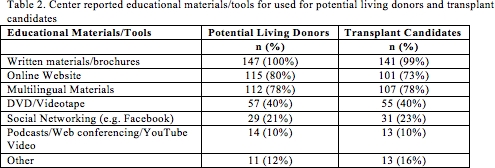National Survey of Living Donor Program Educational Components and Resources
1Vanderbilt University, Nashville
2Montana State University, Bozeman
3Beth Israel Deaconess Medical Center, Boston.
Meeting: 2018 American Transplant Congress
Abstract number: C131
Keywords: Donation, Kidney, Resource utilization
Session Information
Session Name: Poster Session C: Kidney Living Donor Issues
Session Type: Poster Session
Date: Monday, June 4, 2018
Session Time: 6:00pm-7:00pm
 Presentation Time: 6:00pm-7:00pm
Presentation Time: 6:00pm-7:00pm
Location: Hall 4EF
Purpose: Education about living donation (LD) has been identified as a significant barrier to increasing living donation. Little is known about how donors and transplant candidates are educated by the transplant centers. This national study describes the educational components and resources available within LD programs.
Method: A mailed survey was sent to the living donor coordinator (LDC) at every U.S. LD program (n=211; response rate=70%, total respondents=148). Descriptive statistics summarized survey responses.
Results: Median reported education time per donor was 90 minutes (IQR 60-120) (Table 1). Median education time per transplant candidate about LD was 20 minutes (IQR 10-30) with 27% reporting < 10 minutes and 20% reporting >30 minutes. Table 1 indicates the types of programs and resources offered by LD programs. 58% offered financial counseling programs and 56% trained transplant candidates and/or social networks on how to identify/approach potential LDs. LD education at dialysis units (34%) and to referring nephrologist (29%) were the least offered programs. Materials/tools used in the education of potential LD and transplant candidates are described in Table 2. Written materials/brochures were the most common tools for living donors (100%) and transplant candidates (99%). Online website and multilingual materials were also frequently used. The types of living donor financial assistance programs included as part of living donor education: 89% the National Living Donor Assistance Center (NLDAC), 37% fundraising, and 26% state tax deduction/credit.
Conclusion: Identification of transplant center educational methods and resources is an important first step to exploring educational barriers and developing interventions to overcome these barriers. 

CITATION INFORMATION: Moore D., Dietrich M., Buerhaus P., Rodrigue J., Minnick A. National Survey of Living Donor Program Educational Components and Resources Am J Transplant. 2017;17 (suppl 3).
To cite this abstract in AMA style:
Moore D, Dietrich M, Buerhaus P, Rodrigue J, Minnick A. National Survey of Living Donor Program Educational Components and Resources [abstract]. https://atcmeetingabstracts.com/abstract/national-survey-of-living-donor-program-educational-components-and-resources/. Accessed December 13, 2025.« Back to 2018 American Transplant Congress
